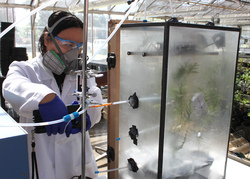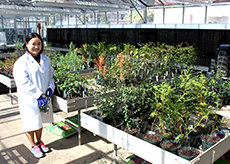SFA graduate student analyzes vegetation for air quality improvement
July 22, 2015
 Stephen F. Austin State University graduate student Marife Anunciado measures the ammonia concentration inside a controlled chamber, located inside the Arthur Temple College of Forestry and Agriculture greenhouse. Funded by the Natural Resources Conservation Service, her research will provide insight into the most effective vegetation for reducing air contaminates from large-scale poultry farms. Photo courtesy of Sarah Fuller
Stephen F. Austin State University graduate student Marife Anunciado measures the ammonia concentration inside a controlled chamber, located inside the Arthur Temple College of Forestry and Agriculture greenhouse. Funded by the Natural Resources Conservation Service, her research will provide insight into the most effective vegetation for reducing air contaminates from large-scale poultry farms. Photo courtesy of Sarah Fuller
According to Anunciado, concentrated animal feeding operations are one of Texas' primary food providers. CAFOs supply commodities for items such as chicken, beef and pork products. Due to the sheer concentration of livestock and the subsequent waste produced, these operations are regulated by the Environmental Protection Agency through the Clean Water Act.
Anunciado said ammonia is one of the most generated waste byproducts of livestock production; therefore, its management is a top priority.
Under the direction of Dr. Sheryll Jerez, associate professor of environmental science at SFA, Anunciado is investigating herbaceous species that may effectively reduce the air contaminant.
"This is actually an initial study to identify an effective shelterbelt to be established at poultry farms that will help minimize impact and dispersion of ammonia to nearby communities," Anunciado said.The Natural Resources Conservation Service website explains that shelterbelts, or windbreaks, are tree and shrub barriers often used in agriculture to prevent erosion, protect livestock and reduce noise. Anunciado will investigate the rate of ammonia absorption in certain tree species, providing insight into the most effective vegetation to use in shelterbelts surrounding poultry farms.
Her research, funded by the NRCS, will focus on six species: American holly, Arizona cypress, arborvitae, Eastern red cedar, yaupon holly and roughleaf dogwood.
To help ensure scientific accuracy, her analysis will be conducted in a controlled chamber located in the college's greenhouse. She will expose the six tree species to varying doses of ammonia while carefully documenting their physiological responses such as photosynthesis and transpiration. The results will indicate any possible changes elicited by the plant's exposure to the chemical.
Anunciado said that air velocity, light intensity, temperature, relative humidity and ammonia concentration will all be closely monitored using a variety of specialized tools.
Furthermore, she plans to determine the actual amount of ammonia absorbed by each species, as well as construct an air pollution tolerance index. The higher a plant's air pollution index, she explained, the more tolerant the species is to air pollution.
In addition to Anunciado's lab analysis, Jerez said they also are collecting ammonia absorption data from vegetation currently planted at SFA's poultry facilities, located at the Walter C. Todd Agricultural Research Center. This, along with Anunciado's controlled lab measurements, will serve as a foundation for Jerez's continued exploration of the subject.
"Determining plants' index on air pollution tolerance will be helpful in the planning of environmental control efforts from a poultry industry's perspective," Anunciado said. "Instead of solely providing an appealing landscape, tolerant plants can become an effective shelterbelt, capturing ammonia and reducing environmental impact."
Anunciado, an international student from the Philippines, previously obtained a Bachelor of Science in environmental science, focusing on agroforestry-based technology use among upland farmers of the Philippines.
For more information on this and other research, visit the college's website at www.atcofa.sfasu.edu or call (936) 468-3301.
